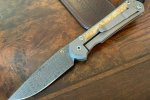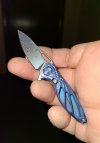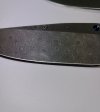-
The BladeForums.com 2024 Traditional Knife is ready to order! See this thread for details: https://www.bladeforums.com/threads/bladeforums-2024-traditional-knife.2003187/
Price is$300$250 ea (shipped within CONUS). If you live outside the US, I will contact you after your order for extra shipping charges.
Order here: https://www.bladeforums.com/help/2024-traditional/ - Order as many as you like, we have plenty.
You are using an out of date browser. It may not display this or other websites correctly.
You should upgrade or use an alternative browser.
You should upgrade or use an alternative browser.
What is Damascus? A true definition
- Thread starter Rusty Shakleford
- Start date
J. Doyle
Knifemaker / Craftsman / Service Provider
- Joined
- Feb 17, 2008
- Messages
- 8,266
These pics might be interesting to some in this thread.
These blades are forged, simple carbon monosteel. They all have hamon and this is half way through my etching/polishing process. Notice the extensive banding....the "watered"/wootz like pattern.....in the black, hardened area of all three blades.
Again, these are NOT Damascus or San Mai blades....just simple high carbon stee.
W2
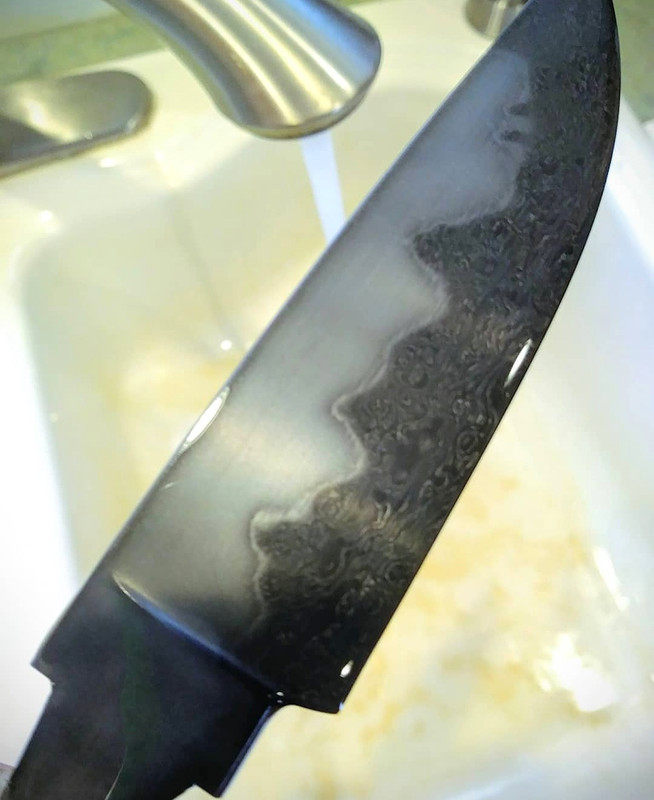
1095
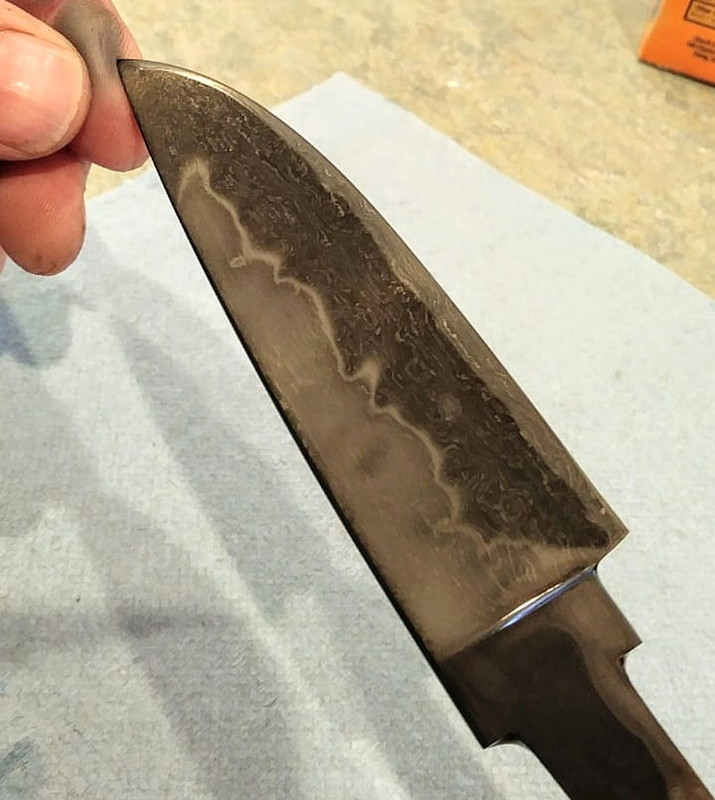
1075
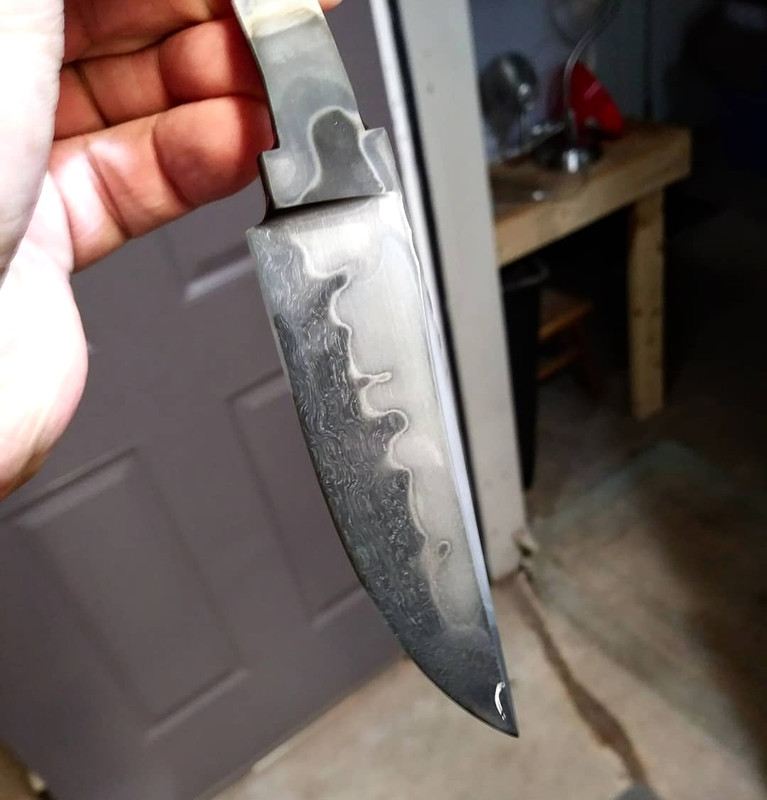
These blades are forged, simple carbon monosteel. They all have hamon and this is half way through my etching/polishing process. Notice the extensive banding....the "watered"/wootz like pattern.....in the black, hardened area of all three blades.
Again, these are NOT Damascus or San Mai blades....just simple high carbon stee.
W2

1095

1075

VorpelSword
Gold Member
- Joined
- Dec 27, 2007
- Messages
- 1,635
Historically correct Damascus is forvever lost (the way to make it).
Modern Damascus is the best we can do to replicate it.
I assume everybody in the knife world already know this, so whenever we say "damascus", we mean "modern pattern welded damascus", not "historically accurate damascus".
"Damascus"
Look it up here:
A good discussion. Good info.
The history of "Damascus" is very interesting.
Fast forward to modern times and my understanding is that real Damascus is pattern welded steel from multiple layers. It's not necessary to use 2 different steels, people do that so that they will etch differently and show the pattern. I used to think that pattern welded steel was used in ancient times because they didn't have modern furnaces to heat steel to high enough temperature to distribute the elements such as carbon throughout the steel.
I toured a steel mill recently and watched the melting process and heard a description of the alloying. They fill the furnace with scrap, typically shredded steel from old cars and stuff like that. They melt it with very high electric current through electrodes then pour the molten steel into a ladle. They do a chemical analysis of what is in the ladle and if necessary they add elements to bring up the carbon content, etc. They stir the molten steel in the ladle with injections of argon gas, and I think this happens pretty quickly. This is the technology that we have now that they didn't have in ancient times. This particularly steel mill made structural steel and reinforcing steel, but also made higher alloy steels such as automotive leaf springs. They didn't make anything esoteric. They use steel rollers to roll out plates and bars from the hot ingots. I tried asking what steel they used for these rolls but nobody could tell me. The closest I got was that it is "carbide steel". They machine the rollers on large lathes so I doubt if it's pure carbide.
I'm not sure that there is an advantage to pattern welded steel with respect to physical properties, but it is certainly an art form.
I don't understand what the cheap knives are that look like Damascus. Are they actually some form of pattern welding? Are they just some form of surface pattern? I don't know how they can create it for such a low price.
Fast forward to modern times and my understanding is that real Damascus is pattern welded steel from multiple layers. It's not necessary to use 2 different steels, people do that so that they will etch differently and show the pattern. I used to think that pattern welded steel was used in ancient times because they didn't have modern furnaces to heat steel to high enough temperature to distribute the elements such as carbon throughout the steel.
I toured a steel mill recently and watched the melting process and heard a description of the alloying. They fill the furnace with scrap, typically shredded steel from old cars and stuff like that. They melt it with very high electric current through electrodes then pour the molten steel into a ladle. They do a chemical analysis of what is in the ladle and if necessary they add elements to bring up the carbon content, etc. They stir the molten steel in the ladle with injections of argon gas, and I think this happens pretty quickly. This is the technology that we have now that they didn't have in ancient times. This particularly steel mill made structural steel and reinforcing steel, but also made higher alloy steels such as automotive leaf springs. They didn't make anything esoteric. They use steel rollers to roll out plates and bars from the hot ingots. I tried asking what steel they used for these rolls but nobody could tell me. The closest I got was that it is "carbide steel". They machine the rollers on large lathes so I doubt if it's pure carbide.
I'm not sure that there is an advantage to pattern welded steel with respect to physical properties, but it is certainly an art form.
I don't understand what the cheap knives are that look like Damascus. Are they actually some form of pattern welding? Are they just some form of surface pattern? I don't know how they can create it for such a low price.
Jsega51
Gold Member
- Joined
- Feb 11, 2015
- Messages
- 9,136
I don't understand what the cheap knives are that look like Damascus. Are they actually some form of pattern welding? Are they just some form of surface pattern? I don't know how they can create it for such a low price.
Some have the pattern simply etched on them to fake it, others really are different steels welded together, but the quality of steel and forging is pretty bad. Kyle Royer MS has bought some and actually broken the blades into pieces to examine them finding all sorts of inclusions and other problems with the grain structure, not to mention really bad fit and finish when it came to the handles.
Here is an Al Pendray Wootz Bowie with Ivory scales. The Buck 110 has a Pendray Wootz blade. The Damascus that blew me away was the pattern welded feather Damascus knife.
View attachment 1911006View attachment 1911010View attachment 1911011View attachment 1911012
View attachment 1911006View attachment 1911010View attachment 1911011View attachment 1911012
- Joined
- Jul 24, 2022
- Messages
- 89
See, this here is what I like to see. Folding and pattern welding these two steels together is largely just aesthetic. VG-10 alone would be a better choice than these two Chinese Sandvik steels. Manufacturers should have to disclose the the steels they use when creating pattern welded steel.The Civivi Damascus is made with 9Cr18Mov and 10Cr15CoMov. The former is a decent budget steel on its own. The latter is a Chinese analog of VG-10. This modern "Damascus" is supposed to get reasonable edge retention for something that people primarily buy for looks. I have some but I really haven't put much use on it.
As far as looks, different grinds and finishes do different things. Pictures don't always do it justice. Here is my Elementum. My Governor has a much different look. I'll try to dig it out later this week or next for a picture.

- Joined
- Aug 5, 2001
- Messages
- 4,306
Folding and pattern welding these two steels together is largely just aesthetic.
ALL damascus is largely aesthetic regardless of steel types used, although good forging and heat treatment can make a suitable working knife.
Manufacturers should have to disclose the the steels they use when creating pattern welded steel.
Pakistani damascus not withstanding, many manufacturers will (or do) disclose the types of steel used.
I am still not sure what you are driving at in this entire thread, and your comments within. You are trying to make it seem that modern damascus is a deception or fraud, and you are trying (and failing) to build some sort of conspiracy theory around it.
Last edited:
Chronovore
Gold Member
- Joined
- Aug 29, 2019
- Messages
- 11,851
See, this here is what I like to see. Folding and pattern welding these two steels together is largely just aesthetic. VG-10 alone would be a better choice than these two Chinese Sandvik steels. Manufacturers should have to disclose the the steels they use when creating pattern welded steel.
I don't know what you mean by "Chinese Sandvik steels". As far as combinations of steels versus those steels in isolation, has anyone done testing to show how much difference should be expected? I'd love to see some reasonably controlled testing between WE's 9Cr18Mov, 10Cr15CoMov, and their combination in the Civivi Damascus.
Otherwise, is VG-10 better than 10Cr15CoMov? They are analogs and should be pretty close on composition. In reality, performance will have more to do with heat treatment. That isn't just true when the recipe is close either.
For instance, while 9Cr18Mov is a decent budget steel on its own, WE gives it an exceptional heat treatment in the Civivi and Sencut knives. As a result, they can often hold a better edge than Spyderco knives in VG-10. That said, I've been very curious to see how well WE does their 10Cr15CoMov in isolation. Is their high-performance 9Cr18Mov just an anomaly? (On premium steels in knives made outside of China, Spyderco tends to do a better heat treatment than WE.)
- Joined
- Jul 24, 2022
- Messages
- 89
I misspoke when I called it Sandvik steel, that's a whole separate class of steels entirely. All the letters and numbers in the designations confuse me. That being said, now that I know it's those two steels in WE knives, ill never buy a Damascus knife made by them.I don't know what you mean by "Chinese Sandvik steels". As far as combinations of steels versus those steels in isolation, has anyone done testing to show how much difference should be expected? I'd love to see some reasonably controlled testing between WE's 9Cr18Mov, 10Cr15CoMov, and their combination in the Civivi Damascus.
Otherwise, is VG-10 better than 10Cr15CoMov? They are analogs and should be pretty close on composition. In reality, performance will have more to do with heat treatment. That isn't just true when the recipe is close either.
For instance, while 9Cr18Mov is a decent budget steel on its own, WE gives it an exceptional heat treatment in the Civivi and Sencut knives. As a result, they can often hold a better edge than Spyderco knives in VG-10. That said, I've been very curious to see how well WE does their 10Cr15CoMov in isolation. Is their high-performance 9Cr18Mov just an anomaly? (On premium steels in knives made outside of China, Spyderco tends to do a better heat treatment than WE.)
- Joined
- Aug 5, 2001
- Messages
- 4,306
That being said, now that I know it's those two steels in WE knives, ill never buy a Damascus knife made by them.
I'm sure they will be devastated.
Carry on with your little damascus conspiracy theory thing.....
Last edited:
- Joined
- Jul 20, 2021
- Messages
- 9,930
- Joined
- Sep 19, 2001
- Messages
- 8,968
Wootz, bulat, watered steel, it's the same as Damascus of antiquity. Ancient examples have been studied, processes replicated, tons of knives made. Weird how the mysticism exists when YouTube is full of videos of the steel being made and the blades being forged.
Though I find similar confusion multiple times a day on a huge variety of subjects. The sum total of human knowledge available at fingertips across the entire first world, but nobody uses a search engine.
Though I find similar confusion multiple times a day on a huge variety of subjects. The sum total of human knowledge available at fingertips across the entire first world, but nobody uses a search engine.
Chronovore
Gold Member
- Joined
- Aug 29, 2019
- Messages
- 11,851
I misspoke when I called it Sandvik steel, that's a whole separate class of steels entirely. All the letters and numbers in the designations confuse me. That being said, now that I know it's those two steels in WE knives, ill never buy a Damascus knife made by them.
To summarize: you misspoke in a text-based format about a whole class of steels and are confused by the letters and numbers in steel designations.
Therefore, a company using two respectable budget steels to make budget Damascus for use in well-made budget knives is a bad thing...
J. Doyle
Knifemaker / Craftsman / Service Provider
- Joined
- Feb 17, 2008
- Messages
- 8,266
That is completely incorrect.I had always read that Damascus was a harder steel and a softer steel to achieve flexibility combined with edge retention in a sword. That was the grail of sword production.
- Joined
- Jul 20, 2021
- Messages
- 9,930
Can you please give us a better description of how it is put together; and why?That is completely incorrect.
Glenn Goodlett
Gold Member
- Joined
- Sep 6, 2016
- Messages
- 1,397
I think that is San Mai.I had always read that Damascus was a harder steel and a softer steel to achieve flexibility combined with edge retention in a sword. That was the grail of sword production.
J. Doyle
Knifemaker / Craftsman / Service Provider
- Joined
- Feb 17, 2008
- Messages
- 8,266
Sure...I'll try. I touched on some of this in my comments above.Can you please give us a better description of how it is put together; and why?
Old "Damascus", wootz, watered steel....even ancient Japanese tamahagane...all differ from what is known/called Damascus today in the fact that they were all (relatively) homogeneous, mono steel...all the same type of steel to start.
Today's Damascus..... (maybe more accurately called "pattern welded" steel but I will also call it Damascus because this is what everyone today means when they use the term and everyone knows what we're talking about)....is made of two or more separate alloys forge welded together in alternating, pattern arranged layers to create a visually distinct contrasting pattern.
The "why" is easy........to create a visually interesting (subjective), and artistically expressive unique blade. That's it.
No serious ethical maker I know really believes that mixing two steels together somehow magically makes a "better/superior" blade. But we need to be careful.....because it doesn't AUTOMATICALLY make it an inferior blade either.
I'll say it again.....Damascus blades are NOT AUTOMATICALLY inferior blades. Stay with me.....more on this in a minute.
Only a fool or a hack/scammer would intentionally use bad inferior steel in a blade just to get a contrasting pattern.
VERY IMPORTANT: If any single steel in a Damascus mix wouldn't make a good stand-alone, monosteel knife blade then it DOESN'T belong in a Damascus blade. (There are one or two special exceptions I won't get into here but extreme care is taken to keep those materials away from the cutting edge.)
This next bit assumes the smith/maker/manufacturer is competent and cares about the quality of their products.
Steels for Damascus are chosen carefully, not only for the contrast they can offer but also their compatibility, specifically in their thermal properties and heat treating regimen.
So let's consider far and away the single most common Damascus steel combo: 1080/1084/1095 & 15n20. (There are other good combos but again, I'll save that for another time.
There's a reason the 10XX series of steels are so frequently mixed with 15n20. They all have VERY similar (nearly identical) heat treat protocol and very similar expansion/contraction rates/properties during thermal treatments.
Likewise, 15n20 is really just 1075 with a good bit of nickel added. 1075 is another good 10XX series steel with the same heat treating and thermal properties as those listed above.
This is going to make them want to weld to each other very easily and play together very nicely during the heat treating regimen.
So a blade made from 1095 & 15n20 will be uniformly and evenly hardened throughout and behave as a single monosteel except that when etched, the nickel in the 15n20 resists attack from the etchant and stays shiny. These are the silver layers in the pattern. While the 1095 is attacked (eaten away a tiny bit) and darkened by the etchant. These are the black/dark gray layers in the steel.
Both 1095 and 15n20 will make excellent stand-alone monosteel blades. But mixed, they cannot produce a blade that is somehow superior to either 1095 or 15n20.
But conversely, the two mixed will not produce a blade inferior to either 1095 or 15n20.

